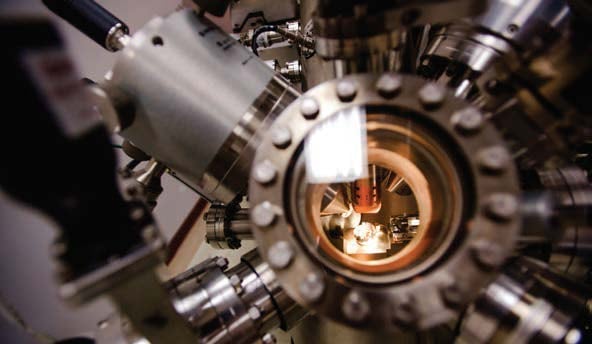Some people say scientific research doesn’t happen in a vacuum. Kathryn Perrine, assistant professor of chemistry, would argue otherwise. The field of surface science has made advances in several fields, from transistors in semiconductor technologies, to bioadhesives for medical devices, batteries and catalysts for energy conversion. Modern surface science utilizes surface-sensitive analytical techniques to measure and characterize materials in a pristine atmosphere, in a vacuum of pressures near-equivalent to those of outer space. Under these conditions, one is able to control the adsorption of gases and allow for electron-based spectroscopies to interrogate the surface providing new insights into atomic bonding and molecular reactions.
In particular, one such instrument that Perrine brought to Michigan Tech was X-ray photoelectron spectroscopy (XPS). This technique enables researchers to measure elemental composition, oxidations states, and chemical binding. In 2016 the XPS was donated to Michigan Tech by the Army Research Laboratories with help from the Department of Chemistry. The XPS is housed in the university’s Applied Chemical and Morphological Analysis Laboratory, and is run by Kathryn Perrine and Timothy Leftwich, research professor in the Materials Science and Engineering Department, both of whom are surface scientists.
Currently, Perrine and her research team are studying oxidation reactions on iron surfaces. These materials are earth-abundant and act as catalysts in the natural environment, undergoing oxidation-reduction and decomposing environmental contaminants. Past studies have shown that iron surfaces are catalysts that have largely impacted nitrogen fixation in the agriculture industry, and are also important to the energy sectors. Currently, Perrine and her group are investigating dechlorination and corrosion mechanisms on iron interfaces for understanding water quality, and also the impact that ions play in aqueous environments affecting infrastructure degradation, among other fundamental processes.
“We are working to unravel fundamental surface mechanisms at complex interfaces, such as the liquid-solid interface, and connecting them with reactions at the gas-solid interface. At the gas-solid interface, we can control water vapor and other chemicals that adsorb to a surface. Scaling these reactions up to atmospheric pressures, and even into the condensed phase, allows us to measure how humidity, oxygen, and other dissolved species in water are transformed on the surface of iron materials.”
This knowledge helps to tackle societal challenges related to energy and to water; two key elements driving our technology forward and also preserving our precious resources. Ultimately the technologies we take for granted today were and are impacted by chemistry and surface science.
